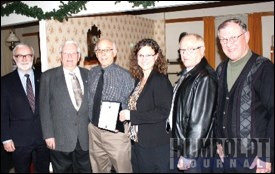Back in June, it was honoured in front of a local crowd with a couple of dignitaries when two new projects were unveiled on the land, but on Nov. 19 the Original Humboldt Site received national attention.
The local project was given honourable mention for the 2013 Governor General's History Award for Excellence in Museums: History Alive!, an initiative established in 2011 by the Canadian Museums Association (CMA) and Canada's History Society (CHS) to "honour significant achievement in the historical field," according to the CMA's official website.
Although narrowly losing out to a museum based in Montreal, Que., for the award, the Humboldt & District Museum & Gallery (HDMG) and its Original Humboldt committee, were acknowledged for their contributions to a better understanding of Canada's history, culture and society.
"To have it acknowledged at this level is a testament to the vision and efforts of local citizens," said Mayor Malcolm Eaton in a media release.
A municipal heritage property located just a few kilometres out of town, the Original Humboldt Site, which was home to the area's first telegraph station, was purchased from the Faul family (descendants of the property's former owners) in 2009 by the site's committee. Since then, the group has been working on bringing its story to life, from the Weldon family controlling the telegraph station in the late 19th century, to becoming a temporary military encampment in the North-West Resistance of 1885.
Excavations and archaeological digs have been conducted on the land, carried out by Western Heritage, and items like gun cartridges, military amenities - even the skeletal remains of a horse - have been uncovered.
Copious amounts of time, research and effort have been put into making the site a viable tourist attraction, with the objective of erecting walking trails around the property and the replicate of the telegraph station in the near future.
Because of the museum's investment into this project, Eaton decided to nominate it for the award, with letters of support ranging from Wendy Fitch, executive director for the Museums Association of Canada, to Robert Doucette, president of Métis Nation Saskatchewan.
"[Our nation] was consulted in the planning of the Métis aspect of Original Humboldt and we were happy to ensure that the project is accurate in its historical teachings," Doucette said in his endorsement letter.
Fitch noted that the project goes deeper than just being a traditional exhibit but instead embodies "a much richer, in depth telling of multiple stories," complete with the replicate telegraph station and Red River Cart.
By Nov. 19, Hoesgen, on behalf of the museum, was in Ottawa to accept the honourable mention for the History Alive! Award at Rideau Hall, given to her by none other than Governor General David Johnston.
At a post-celebration Dec. 4 at the museum, congratulatory letters were read out by committee members: MLA Donna Harpauer gave her "sincerest congratulations", while MP Brad Trost applauded the project in his letter for making it possible "for our generation to teach children our history."
"This project just keeps on going; there's no ending," Hoesgen said at the reception afterward.
"We're constantly finding out new things," she said, alluding to not just the archaeological digs that are held every summer at the site, but information passed on to the committee by family members of the Weldon and Faul family.
The most touching and awe-inspiring phone call came from a descendant of Catherine and George Weldon, the husband and wife team who established Humboldt's telegraph station in 1878 and, during a cruel, harsh at the isolated station, lost their beloved infant daughter, Birdie, when she succumbed to an infection behind the tonsils known as quinsy, an ailment easily treatable nowadays with antibiotics.
Back then, it wasn't, and little Birdie lost her life at the tender age of four, in January, 1882.
"On Saturday, January 28, 1882, our darling little Birdie left us to join the angels above the skies," George Weldon wrote in his diary, noting she had become critically ill two days before Christmas.
The Weldons wanted to give their daughter a Christian burial but, given the frozen land and blocked trails, their only option was to keep her tiny body frozen all winter. Two linemen at the station refused to see this happen to the Weldons, as their despair was palpable, and they trekked via sled for days and days in the middle of a prairie winter to Prince Albert so Birdie could be buried in a proper cemetery.
That was in 1882.
Now, 131 years later, Humboldt's museum has a direct connection back to this tragic, and yet courageous, event.
"A lock of Birdie's hair," Hoesgen said. "We were contacted recently and given her hair," she smiled, noting its soft blonde colour that was so well-preserved, it has survived for well over a century.
"It's things like this that keep us going," Hoesgen said. "What will we find next? What other pieces of the past will come to light?"




